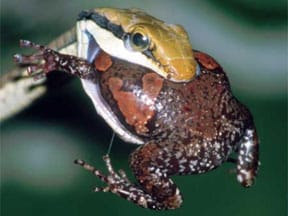Known as the pearl of the Indian Ocean, Sri Lanka boasts a wide variety of unique reptiles.
My Sri Lankan journey started with my friend, Gerry Czaja, picking me up at the airport. Driving by car is more expensive but provides independence from crowded buses, packed trains and unnerving taxi drivers. After a few days at his home in Puttalam, we went to my favorite place in Sri Lanka: the Sinharaja Forest, the country’s last viable rain forest, near the city of Ratnapura. The last time I visited was in 1980, and I used a tent. Today you can stay at Martin’s Place, a lodge with a friendly atmosphere and all-inclusive service. It is not a first-class hotel, but you will get everything you need.
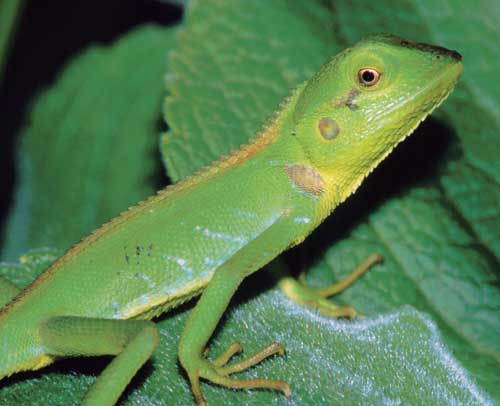
Photo Credit: Peter Janzen, Ph.D.
Have a look on the hedges in Nuwara Eliya, and you will find beautiful lizards like this young Calotes nigrilabris.
Those wishing to enter the Sinharaja Forest may only do so with a guide during the day. You may book your guide and buy entrance tickets at a ranger station located less than 2 miles from Martin’s lodge. The night is a more interesting time to visit tropical forests, but you are not allowed to do so in the Sinharaja Forest. As an alternative, you can herp around the grounds of Martin’s Place at night. You will find an ample number of amphibians and reptiles by listening for their calls.
The Sri Lankan Adventure Begins
In the early morning, we visited the forest, climbing up a hill where the view of the Sinharaja canopy was impressive. The first reptile we encountered was a Sri Lankan horned agama (Ceratophora aspera), a very tiny lizard. Soon after that we spotted a kangaroo lizard (Otocryptis wiegmanni), which is quite common and often found on the ground near the footpaths. Also called Wiegmann’s agama, it is restricted to the wet zone with the exception of small hills within the dry and intermediate zones. This lizard is capable of running on its hind limbs, with its tail raised for a short time. Also present were several day geckos (Cnemaspis spp.). These species are difficult to distinguish. To add to the confusion, six new species from Sri Lanka were described in 2007.
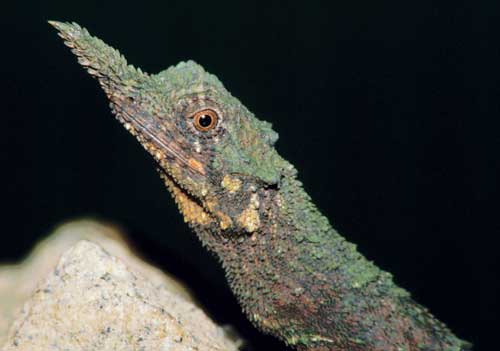
Photo Credit: Peter Janzen, Ph.D.
Only the male Ceratophora aspera has a horn.
The most formidable reptile in the wet zone and in the Sinharaja forest is the hump-nosed lizard (Lyriocephalus scutatus). The largest agamid lizard in Sri Lanka, adults are found clinging to tree trunks. Only the young can be found on the ground. If spotted, the lizard will open its mouth and display its red-colored throat and its teeth. Despite this threat, it won’t bite.
The hump-nosed lizard was also present at our next stop, the city of Kandy in the center of Sri Lanka. Kandy is a must for tourists because of an important relict: the Buddha’s tooth, which is preserved in a temple next to Kandy Lake. Just above the Temple of the Sacred Tooth, you can find a secondary forest named the Udawattakele Reserve. There you will see footless scincid lizards (Nessia spp.), the Boie’s rough-sided snake (Aspidura brachyorrhos) and, if you are lucky, interesting creatures like the giant earthworm (Megascolex coeruleus). We found a specimen measuring a little longer than 24 inches.
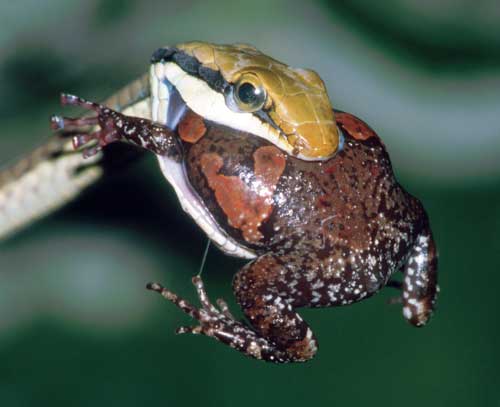
Photo Credit: Peter Janzen, Ph.D.
A Daudin's bronzed-back snake (Dendrelaphis tristis) eats a Sri Lankan bullfrog (Kaloula taprobanica).
Entering the Dry Zone
Sri Lanka’s wet zone is found in the western and central part of the Island. This area has the typical attributes we expect from Sri Lanka, such as tea and tropical rain forests. The wet zone is surrounded by a small intermediate zone, and the rest of the island belongs to the dry zone, which has less rainfall during the year. Rainfall in the wet zone is about 120 to 200 inches per year, and in the dry zone it averages between 40 and 80 inches.
Some specimens of the dry zone are easy to find elsewhere, such as the common garden lizard (Calotes versicolor) and some scincid lizards, including Eutropis spp., Lankascincus spp. and Lygosoma spp. These species can easily be found in garden areas, too. To find the Indian star tortoise (Geochelone elegans), go out early in the morning. After 10 a.m. the sun gets too hot for them. They will find shelter until just before sunset, when they will emerge once again to forage for food. Their reproduction time is during the rainy season, which for the northern and eastern parts of the dry zone is in November and December.
During our trip into the dry zone, we found some interesting reptile species, including one of the new day gecko species named in 2007, Cnemaspis retigalensis, and a second species of kangaroo agama (Otocryptis nigristigma). Female and young of this agama look quite the same as the other kangaroo agama, O. wiegmanni, of the wet zone, but the male is more colorful with yellow laterally and a blue throat.
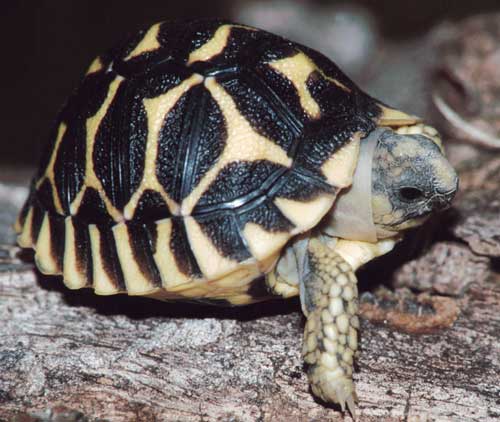
Photo Credit: Peter Janzen, Ph.D.
A one-month-old star tortoise (Geochelone elegans).
Another agamid lizard restricted to the drier parts of the island is the fan-throated lizard (Sitana ponticeriana). Best adapted for a dry, hot climate, the fan-throated lizard can also be found in southern parts of India. It is possible, however, that the Sri Lankan specimens belong to different species.
Species of the dry zone are less often endemic as species of the wet zone tend to be. The dry zone’s climate is similar to the climate of the southern tip of India, and species belonging to the wet zone can’t cross the drier part of Sri Lanka to India. However, wet-zone species are mostly related to species of the Western Ghats in India. Both regions are hotspots of biodiversity.
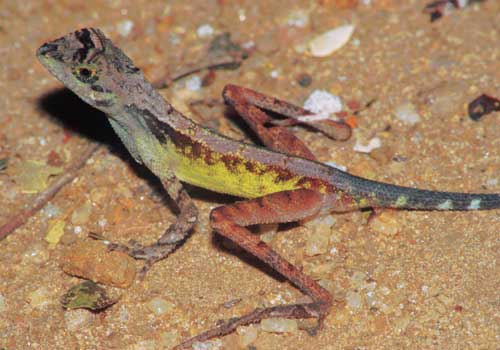
Photo Credit: Peter Janzen, Ph.D.
First described in 2005, Otocryptis nigristigma looks similar to O. wiegmanni, but the males are yellow laterally and have a blue throat.
A dry zone species also found in India is the brown vine snake (Ahaetulla pulverulenta). Also called the brown-speckled whip snake, this slender tree snake has an appendage on the tip of its snout that looks like a long nose. It is actually a projection of the mouth. No one knows its purpose for certain, but it is possible that the fleshy appendage is just part of its camouflage. Like its related species, the green vine snake (Ahaetulla nasuta), it feeds on lizards and frogs. The brown vine snake is often found blending in among the sticks of bushes that have few to no leaves. The green vine snake, on the other hand, is best adapted to bushes with many leaves, where it can blend in. The brown vine snake is restricted to the dry zone and the green vine snake can be found elsewhere, especially next to human settlements. When disturbed, the snake remains motionless and can bite when handled, but the venom is not effective in a human. In fact, if you are not allergic to it, you likely won’t display a reaction at all
Herping Near Humans
A snake often found in garden areas is the common Daudin’s bronze-backed snake (Dendrelaphis tristis). Four species of Dendrelaphis are distributed in Sri Lanka. While visiting at a friend’s place in Gampaha, I spotted a Daudin’s bronze-back preying upon a Sri Lankan bullfrog (Kaloula taprobanica). The snake was very nervous and tried to escape with its prey. After some photos, I let it depart.
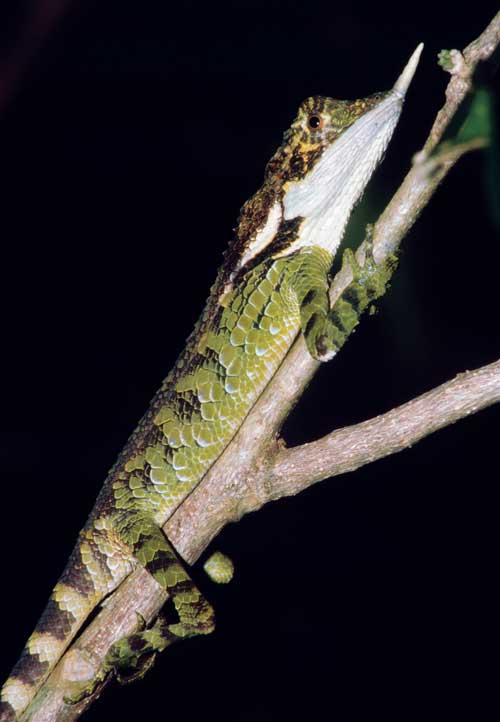
Photo Credit: Peter Janzen, Ph.D.
The author found this male Ceratophora stoddartii in the Central Mountains
When travelling across Sri Lanka, don’t miss places near human settlements. You can find herps there, too. Herps such as the Indian cobra (Naja naja), the Bengal monitor (Varanus benghalensis) and the much larger common water monitor (Varanus salvator) have been spotted close to populated areas. The Bengal monitor is potential food for the local people, but the common water monitor is considered by the locals to be poisonous. Remaining parts of mangrove forest exist north of Negombo, where water monitors are common. In the past, large water monitors visited market places, getting food from the people. Today, unregulated traffic makes roads too dangerous for water monitors to frequent the area and most have left the cities.
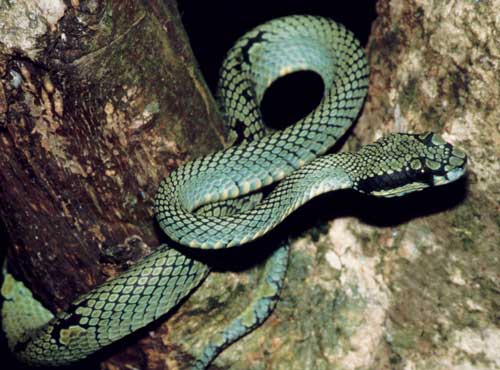
Photo Credit: Peter Janzen, Ph.D.
The Ceylon green pit viper (Trimeresurus trigonocephalus) is a widespread, endemic species in both the wet and dry zones.
The Central Hills of Nuwara Eliya
Nuwara Eliya, found in the central hills, is one of Sri Lanka’s wealthiest cities. It attracts many wealthy vacationers, including a large number of English colonists. It often rains in the central hills and the temperature doesn’t often reach less than 68 degrees Fahrenheit. The nights are cool to cold.
While visiting Nuwara Eliya’s golf course and racetrack, pay special attention to the hedges surrounding them. There you can see black-throated bloodsuckers (Calotes nigrilabris), the only endemic Calotes species found next to human settlements. Although the common green forest lizard (C. calotes) and the common garden lizard (C. versicolor) are also found near populated areas, they are not endemic.
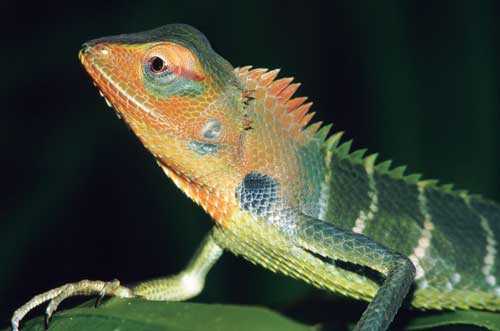
Photo Credit: Peter Janzen, Ph.D.
A male Calotes calotes displays coloration intended to attract females.
If you’re lucky, you can find the rhinoceros-horned lizard (Ceratophora stoddartii). The male of this enigmatic species has a prominent horn, which is much smaller in females. Both sexes can lose this horn, and the function of it is still unclear. I found 10 specimens in an isolated part of a hedge: one male, several females and a few younger lizards. The rhino-horned lizard doesn’t move quickly and is easy to overlook. You won’t find specimens in the sun. They require a shaded area. As captive specimens, they do not do well in habitats that are too warm.
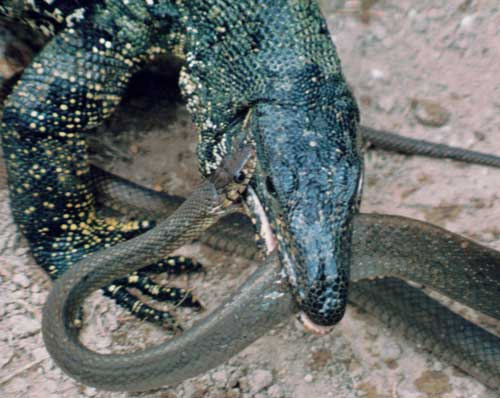
Photo Credit: Peter Janzen, Ph.D.
A common water monitor (Varanus salvator) fights with an Oriental rat snake (Ptyas mucosus).
Top 5 Areas to Explore
1. The most interesting place to go herping in Sri Lanka, and a real paradise, is the Sinharaja Forest, which can easily be reached by hiring a local driver with a four-wheel-drive vehicle. Stay at Martin’s Place for a few days, and enter the forest with a guide during the daytime. You will see a large variety of herp species there.
2. In the hills of Nuwara Eliya there are lots of tea plantations and some remaining forests. From there, make a day trip out of Horton Plains National Park and the Hakgala Botanical Gardens.
3. In the city of Kandy, visit the Temple of the Sacred Tooth and also the Udawattakele Reserve located above the temple. Ask the driver to take you to Trinity College and travel farther up the hill, where you will find the Peradeniya Botanical Gardens. For a real adventure, visit the Gonnaruwa Forest near the botanical gardens. It is a remaining forest, but the most interesting places can be challenging to find. Make a daytrip from Kandy to the Knuckles Mountain Range, where you will find many endemic herp species.
4. Herp lovers should visit Kitulgala, a smaller city at the Kelani Ganga river. This river is where the film The Bridge on the River Kwai was filmed. Stay at the Kitulgala Rest House for a few days, cross the river by boat (they will over-charge you) and explore the forest. A small stream runs quickly through the forest. Both sides of it are interesting, with unique fauna and flora, so keep your eyes open.
5. The dry zone was a bit dangerous due to past political upheaval, but you can go to the area surrounding the Ritigala Strict Nature Reserve. Although you are not permitted to enter, the area does have a cultural center, where you can walk around and search for the new Otocryptis species recently discovered.
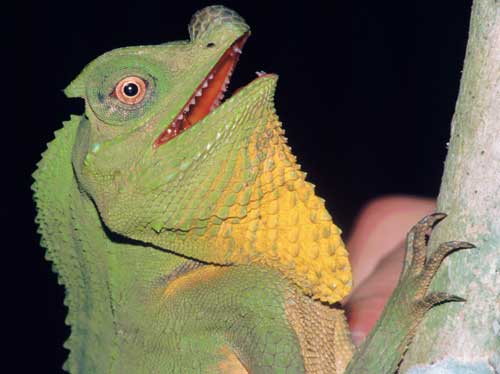
Photo Credit: Peter Janzen, Ph.D.
The largest agamid lizard of Sri Lanka is Lyriocephalus scutatus. This colorful species can be found in rain forests.
Places to Avoid in Sri Lanka
Because of the violence between cultural groups, avoid Colombo and the eastern and northern parts of Sri Lanka. In 2007, several attacks occurred at Yala Park. Instead of these areas, visit the central, western and southwestern parts of the island. Ask to visit cultural areas such as Dambulla, Polonnaruwa and Anuradhapura, but don’t go by bus. Attacks against buses have taken place during the last two years. Avoid military facilities and police stations, and do not visit Sri Lanka during an election. Not every attack was against tourists in the past, but it is best to be safe.
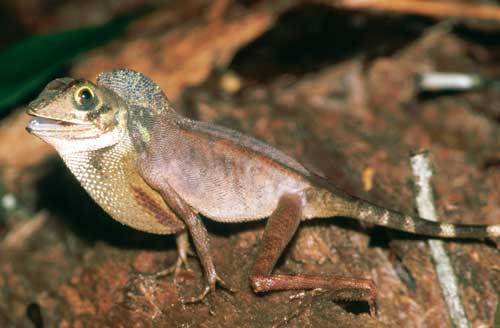
Photo Credit: Peter Janzen, Ph.D.
Otocryptis wiegmanni is easy to find at the Sinharaja Heritage Site. You can often see them close to the footpath
Beware of Leeches
The Sinharaja Forest contains a seemingly endless number of leeches, which lurk in the leaf-litter and on trees.
I would recommend a trip to Sri Lanka to any avid herper. The country is rich in flora and fauna, so be sure to bring your camera. As long as you follow the tips in this article, observe the local laws and listen to your guides, you should have an enjoyable herping adventure that will provide lasting memories. Happy herping.

